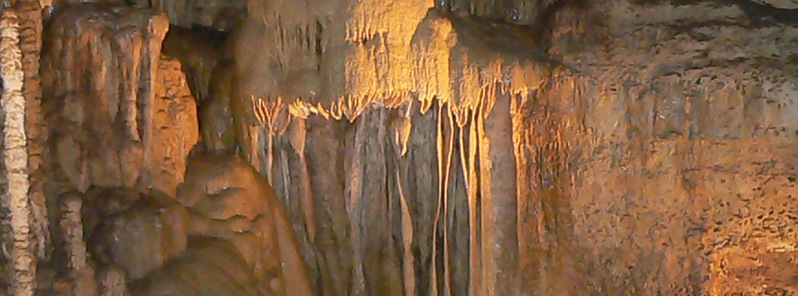New research links 2 000 years of data recorded in stalagmites to tropical storms, floods and El Niño events

Research team led by Rhawn Denniston, professor of geology at Cornell College, has applied a new research technique on the stalagmites in the Australian topics to create a 2 200 year long record of flood events. The new research might help to predict future climate change events.
Stalagmites crystallize from water falling on the cave floors, and slowly, over thousands of years, climate change events are left carved in a stone.
Prof. Denniston's research paper entitled “Extreme rainfall activity in the Australian tropics reflects changes in the El Niño/Southern Oscillation over the last two millennia", published in April 2015, links a precisely dated stalagmite cave flooding events with tropical cyclones, hurricanes and typhoons. His research team discovered that the interior of stalagmites contain distinguishable mud layers, coming from the cave flooding. “Seeing mud accumulations like these was really unusual,” Denniston said. “There was no doubt that the mud layers came from the cave having flooded. The water stirred up the sediment and when the water receded, the mud coated everything in the cave—the floor, the walls, and the stalagmites. Then the stalagmites started forming again and the mud got trapped inside.”
The stalagmites were precisely dated and mud layers were measured. This work, done in cooperation with Denniston's colleagues at the University of New Mexico gave the team over 2 000 years of data on frequency of cave flooding. However, the flood origin remained unclear. Taking into the account the area's climatology, Denniston's team has concluded that the rains probably came from the tropical cyclones or the Australian monsoon.
The research was given an extra boost with Gabriele Villarini, assistant professor of engineering at the University of Iowa, whose are of expertise are extreme meteorological events, their frequency and magnitude, as well as their impact on policy and economics. “The largest rainfall events, almost regardless of duration, are tied to tropical cyclones,” Villarini said.
The team compared flood events recorded in stalagmites to the historical records of tropical cyclones. The comparison revealed that flood event timing coincided with passing of tropical cyclones. From this, the floods can be related to the history of El Niño events in the last 2 200 years, as El Niño is closely related to yearly changes in tropical cyclones around the world. For example, Australia and the Atlantic experience fewer tropical cyclones during the episodes of El Niño, than during La Niña cycle.
“Our work, and that of several other researchers, reveals that the frequency of storms has changed over the past hundreds and thousands of years,” Denniston said. “But why? Could it have been due to El Niño? Direct observations only go back about a hundred years, and there hasn’t been much variation in the nature of the El Niño/Southern Oscillation over that time. Further back there was more, and so our goal was to test the link between storms and El Niño in prehistory.”
The general research conclusion was that variations in flood events which was recorded in the stalagmites clearly matched the number of hurricanes over Atlantic, Gulf of Mexico and the Caribbean.
“Tropical cyclone activity in these regions responds similarly to El Niño, and previous studies had also suggested that some periods, such as those when we had lots of flood layers in our stalagmites, were likely characterized by more frequent La Niñas. Similarly, times with fewer storms were characterized by more frequent El Niños.”
The results of this study mark an important step towards understanding how future climate change may be expressed.
“It is difficult to use climate models to study hurricane activity, and so studies such as ours, which produced a record of storms under different climate conditions, are important for our understanding of future storm activity,” Denniston said.
The next step in the research is establishing a detailed cave monitoring: “We want to extend this study to examine what conditions trigger cave flooding.”, Denniston explains.
Sources: Cornell College, Abstract of the paper – PNAS
Reference:
- "Extreme rainfall activity in the Australian tropics reflects changes in the El Niño/Southern Oscillation over the last two millennia" – Rhawn F. Denniston, Gabriele Villarini, Angelique N. Gonzales, Karl-Heinz Wyrwoll, Victor J.Polyak, Caroline C. Ummenhofer, Matthew S. Lachniet, Alan D. Wanamaker, Jr., William F. Humphreys, David Woods, John Cugley – Proceedings of the National Academy of Sciences of the United States of America (2015) – doi: 10.1073/pnas.1422270112
Featured image: Stalactites and stalagmites in a cave on Kangaroo Island, Australia. Image credit: Ted Mead

Commenting rules and guidelines
We value the thoughts and opinions of our readers and welcome healthy discussions on our website. In order to maintain a respectful and positive community, we ask that all commenters follow these rules:
We reserve the right to remove any comments that violate these rules. By commenting on our website, you agree to abide by these guidelines. Thank you for helping to create a positive and welcoming environment for all.